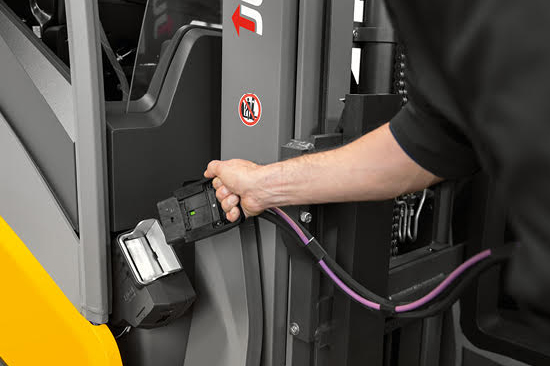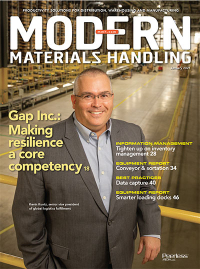Lithium looms large for electric lift trucks
Proper, regular maintenance will help performance of any electric lift truck, even as Li-ion choices expand for DCs drawn by advantages like elimination of battery swaps and battery rooms.
When it comes to the electric lift truck, the biggest trend is the rapid growth of lift trucks powered by lithium-ion (Li-ion) batteries. Not only do analysts predict strong growth for Li-ion powered units, lift truck OEMs are coming up with more models designed to take advantage of Li-ion characteristics, such as energy density and a small form factor and fast charging that makes Li-ion well suited to opportunity charging.
According to analyst firm Interact Analysis, by 2028 Li-ion will be the power for a majority of electric lift trucks sold, and across all power plant types will be 47.3% of the market, up from 16.2% in 2020. Interact also predicts that by 2028 in the Class 3 market, globally 75% will be Li-ion battery forklifts, with many of these in the Chinese market. The analyst firm notes that while Li-ion power does carry a higher initial price point, growth will be spurred by advantages such as superior energy density, cycle life, efficiency, low maintenance and shorter charging.
Multiple lift truck providers have introduced electric lift trucks designed for Li-ion. Generally, these designs feature a reworked cab layout to take advantage of additional room from a smaller battery pack, and have made other changes for enhanced visibility, ergonomics and stability given the different battery size and how that impacts balance.
While it’s possible to run many conventional electric lift trucks on a Li-ion battery, it’s best to check with the lift truck OEM or dealer to ensure that change doesn’t negatively impact the stability or safety of the vehicle, says Jenna Reed, product marketing manager of emerging technologies for Mitsubishi Logisnext Americas. User organizations also have increasing choices when it comes to lift truck models designed for Li-ion, she adds.
“Much like we’ve seen in the consumer electronics space, as products move away from big, bulkier batteries to lighter, smaller and energy dense lithium-ion, the design of these products change, too,” Reed says. “Because lithium-ion batteries are not constrained to any particular shape, forklifts will no longer need to be designed around a battery box. This opens the door to new truck designs and possibilities.”
For example, Li-ion models such as Jungheinrich ETV216i creates more space in the operator cab for better operator ergonomics and visibility, while also making the vehicle compact and stable. Some Li-ion trucks also feature regenerative braking to further enhance energy efficiency.
Because Li-ion batteries charge much faster than conventional lead acid types, with opportunity charging, Li-ion powered units are able to run 24 hours a day, 7 days a week without the need to stop during a shift and change the batteries.
Not only does this eliminate battery swap tasks, it also frees up space in DCs that otherwise need to carve out a battery room. With a trend in industry toward smaller fulfillment centers located close to customer concentrations, this space-saving nature of Li-ion should increase its adoption.
On top of that, these batteries maintain constant voltage and don’t entail tasks like battery watering. Overall, Reed advises that users should assess the total cost of ownership for Li-ion and give them close consideration as they expand their fleets or retire older electric lift trucks. “With all the benefits and advantages that come with having an integrated lithium-ion battery, I expect we will see more forklifts with integrated lithium-ion batteries,” says Reed.
Electric lift trucks that run lead-acid are proven options that will continue to be good choices for many DCs for years to come, Reed adds. However, they do entail additional maintenance practices when it comes to establishing proper battery watering intervals and procedures, which is not an issue with Li-ion.
No type of electric lift truck, not even a Li-ion model, is completely maintenance free, so it’s still a good practice to perform visual checks of cables and connections. An operation can also achieve a longer lasting, more energy efficient fleet with steps such as choosing the right type of truck for the tasks it will be used for, and never using lift trucks for tasks they weren’t designed for in the first place, such as pushing or shoving materials on the floor, or using a forklift to tow trailers, Reed advises.
Solutions such as lift truck telematics, battery management systems or the ability on some newer trucks to program customized performance characteristics (such as speed) to the training level or preferences of individual operators, can further help with electric lift truck performance, says Reed, but proper maintenance is the foundation.
“Some of the most important actions any fleet owner can take to maximize energy efficiency is to maintain and service their equipment regularly,” Reed says. “Regardless of the energy source placed in a forklift, proper equipment care is essential.”

Article Topics
Lift Truck Tips News & Resources
Overlooked no more: The importance of lift truck inspections Lithium transition: It’s all about the outcomes Safety for automatic guided vehicle (AGV) environments Assessing the move to lithium Leasing’s fleet management upside Managing for lift truck operator safety Narrow aisle success: Think systems, then trucks More Lift Truck TipsLatest in Materials Handling
Registration open for Pack Expo International 2024 Walmart chooses Swisslog AS/RS and software for third milk processing facility NetLogistik partners with Vuzix subsidiary Moviynt to offer mobility solutions for warehouses Materials Handling Robotics: The new world of heterogeneous robotic integration BSLBATT is looking for new distributors and resellers worldwide Lucas Watson appointed CSO for Körber’s Parcel Logistics business in North America Hyster recognizes Dealers of Distinction for 2023 More Materials HandlingAbout the Author
Subscribe to Materials Handling Magazine

Find out what the world's most innovative companies are doing to improve productivity in their plants and distribution centers.
Start your FREE subscription today.
April 2024 Modern Materials Handling

Latest Resources












